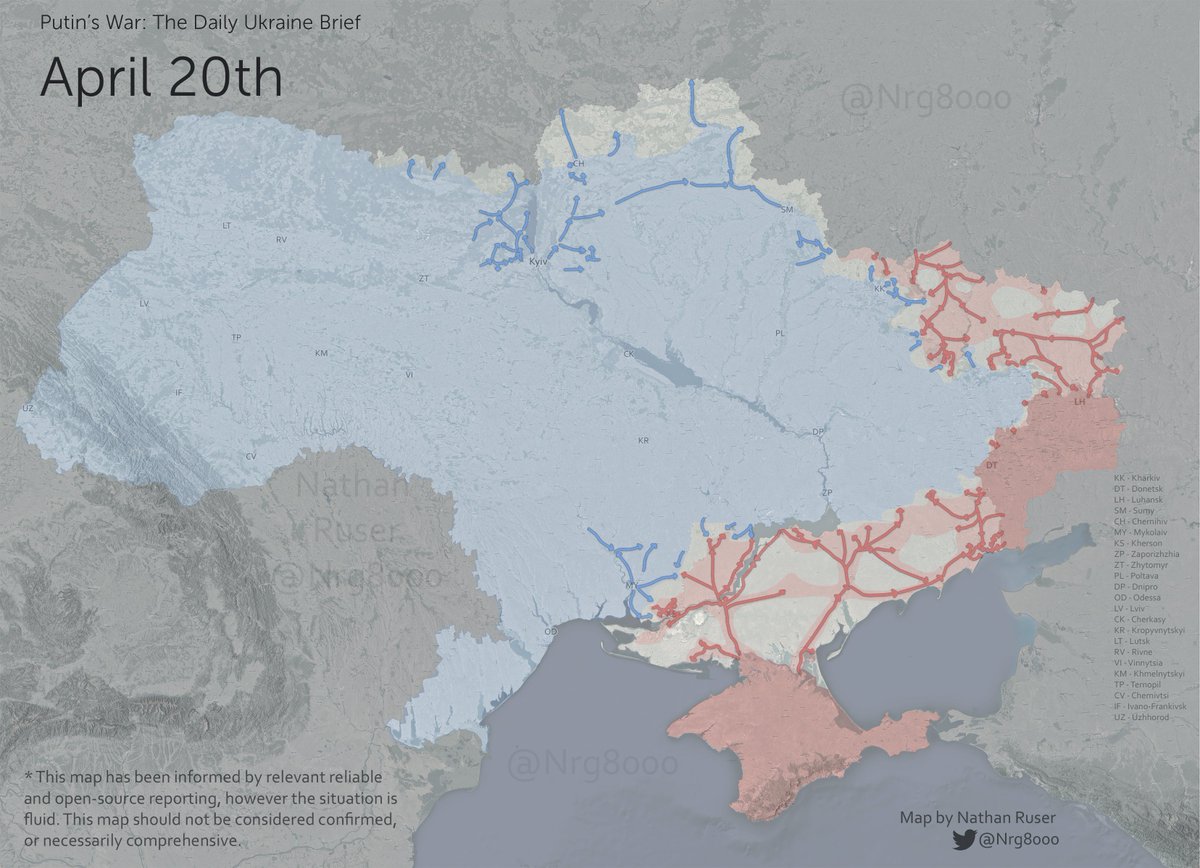I’ve been traveling and not writing much these past two weeks. Some brief thoughts about the second phase of the war, Russia’s offensive to retake the Donbas, and implications. Thread. (map from Nathan below). 1/ 

Without national mobilization, I think the Donbas is the last major offensive the Russian military can attempt given the current state & availability of forces. Whether it succeeds, or fails, the Russian military will be largely exhausted in terms of offensive potential. 2/
The Russian attack thus far seems to be an advance on Slovyansk from Izyum, pressing the Severodonetsk salient, and pushing southwest from Izyum (west of Kramatorsk) to attempt a partial envelopment of UKR positions in the northern part of the Donbas. 3/
This is a risky operation. UKR forces have been reinforcing around Kharkiv, and attacking to threaten the Russian ground lines of communication for this offensive. Even if Russian forces make significant gains, they could be pressed to hold territory and vulnerable afterwards. 4/
UKR forces appear to have conducted a tactical retreat in some areas, blown bridges, and at the same time could position for a counter attack to threaten the sustainment of the Russian offensive. 5/
Russian forces have taken heavy losses in manpower and equipment, with far fewer combat effective formations available. Not clear what we are calling ‘BTGs’ at this point and their level of manning. Russian reinforcements are far from sufficient to replace earlier losses. 6/
In the south, Russian forces had been tied down in Mariupol. Putin’s announcement that they are going to avoid storming Azovstal probably reflects that they can’t afford to lose further manpower and need those units for the Donbas offensive. 7/
Even still, it’s unclear if the southern axis of the planned offensive will be more than a fixing action. The Southern Military District's forces have been mauled over 2 months of fighting. This means a larger operational envelopment is probably beyond their means to support. 8/
Russian forces in the southwest around Kherson city are struggling to consolidate a defensible perimeter west of the river. The units deployed there are relatively light, and under pressure. They could even be forced over time to retreat east across the Dnipro. 9/
Ukraine has been deploying reinforcements to Zaporizhia, Donbas & Kharkiv. Russia has made little effort to disrupt ground lines of communication into the Donbas. This means that a Russian success is at best contingent & UKR could be in position to launch counteroffensives. 10/
Expansion of support to include armor, IFVs, and artillery is going to allow Ukraine to replace losses and equip reserve brigades (esp artillery and ammunition which Ukraine needs). Hence the general trajectory of correlation of forces in this war is not in Russia’s favor. 11/
If the Russian military sends units in piecemeal, sticking to roads, with narrow advances – they will be defeated by UKR as they have in other battles. I’ve seen them make adjustments in some areas, but some of the problems are structural. 12/
Reticent to make any predictions on how the battle for the Donbas will go. These things are contingent, and it depends. The outcome can range from Russian forces making gains to suffering another significant defeat. 13/
Dvornikov's appointment changes little. There’s not much distinguishing him from other Russian generals. The more pertinent question is how/if the Russian military has reorganized command and control, air support, and logistics for this offensive. 14/
Donbas is a relatively urban region. Russian forces likely need Severodonetsk to control Luhansk and Slovyansk + Kramatorsk in order to claim they have captured Donetsk. These could end up prolonged and costly fights in urban terrain. 15/
I think it is fair to say that the decisive period of the war was the first three weeks (maybe even first 4 days). Whatever happens in this next phase, the Russian military is likely to exhaust its offensive potential in the near term. 16/
Does this presage a stalemate? Not necessarily. UKR has its own offensive options. Russia may next try to consolidate control over territory held and pressure UKR via blockade. Its too early to predict what the next phase might look like & it depends on what UKR chooses to do.
Sorry opening post should say 'take' not 'retake' - blame jetlag.
I’m going to make another follow up thread on force availability, with some added info since the last time I addressed that subject.
• • •
Missing some Tweet in this thread? You can try to
force a refresh







